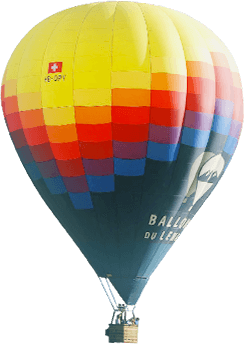
How a hot-air balloon works: a journey to the heart of the skies
Hot-air balloons fascinate young and old with their majestic ascent and smooth flight. But how exactly do they work? Marie (8) and Grégoire (9) asked Gaël, hot-air balloon pilot and founder of BALLONS du LEMAN. Discover the secret of these giants of the air, and how a hot-air balloon flight works.
Marie: What makes a hot-air balloon fly?
Gaël: The principle of hot-air balloon flight…
Hot-air ballooning is based on a simple principle: hot air is lighter than cold air. By heating the air in the envelope (the balloon) with propane-fuelled burners, the balloon becomes lighter than the surrounding air and rises.
Conversely, to descend, you simply let the air inside the balloon cool down, or open a valve (also known as a parachute) at the top of the envelope, allowing the hot air to escape.
Grégoire: What are the key elements of a hot-air balloon?
Gaël: A hot-air balloon is made up of several essential elements:
- The envelope: this large, strong fabric balloon contains the hot air.
- The basket: the wicker basket in which the passengers and pilot sit.
- Burners: produce a flame to heat the air inside the envelope.
- Propane tanks: powering the burners to keep the balloon in flight.
- The parachute (or valve): an opening at the top to regulate temperature and descent.
Marie: How does a balloon flight work?
Gaël: A hot-air balloon flight is an unforgettable adventure that generally begins well before the ascent. There are several phases:
- Preparation and inflation
The team deploys the envelope on the ground and starts inflating it with a fan. The burners then heat the air, and the balloon gradually rises. - Take-off
Once the air is sufficiently warm, the balloon takes off smoothly, offering a magical floating sensation. - Flying
Unlike aircraft, a hot-air balloon cannot be steered precisely. It moves with the wind, the pilot adjusting altitude to take advantage of different wind layers and slightly modify the trajectory. - Landing
After a flight of around an hour, the pilot looks for an open spot to land the balloon gently. The ground crew follow the balloon and witness the landing. - Returning and sharing
Once on the ground, passengers sometimes help to fold the envelope, before celebrating the experience with a balloonist’s toast.
Grégoire: Would you recommend a balloon flight?
Gaël : Absolutely! It’s an experience you have to have at least once in your life!
A hot-air balloon flight is a moment out of time, a magical moment, an opportunity to see the world from a new angle. It’s a unique experience, accessible to all, that leaves lasting memories. Free as a bird, you float through the air to discover sumptuous panoramas, between lakes and mountains….

